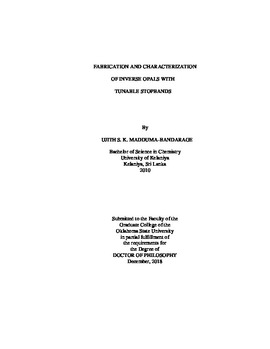| dc.contributor.advisor | Vasquez, Yolanda | |
| dc.contributor.author | Madduma-Bandarage, Ujith S. K. | |
| dc.date.accessioned | 2019-08-19T15:38:36Z | |
| dc.date.available | 2019-08-19T15:38:36Z | |
| dc.date.issued | 2018-12 | |
| dc.identifier.uri | https://hdl.handle.net/11244/321159 | |
| dc.description.abstract | Inverse opals, a major type of self-assembled structures, provide good examples of photonic crystals that result from the periodic arrangement of voids. The periodic arrays of voids interfere with the light passing through them and prevent the propagation of certain wavelengths (stopband). The ability to tune the stopband of an inverse opal is important in applications such as photonics and sensing. Inverse opal films can be fabricated by filling the interstitial sites of self-assembled colloids with a precursor solution and then removing the template (assembly of colloids) by means of heat or chemical dissolution. However, the fabrication of inverse opals with long range ordering of voids by using traditional methods is challenging due to the introduction of defects. Co-assembly is an evolving technique that is used to generate inverse opals with minimal defects but the use of experimental conditions to control the defects has not been widely explored. In this study, silica-based inverse opals were fabricated by using co-assembly technique and the quality of the resultant films was evaluated with respect to the colloidal concentration and sol-gel precursor concentration. To tune the stopband, the size of voids was altered by varying the size of colloids. Also, another type of inverse opals was produced from a cross-linked polymer based on 2-hydroxyethyl methacrylate which can result tunable stopbands in response to the external stimuli. The mechanical and dimensional stability of the polymer inverse opals were improved using a poly(dimethylsiloxane) mold. Overall, defect-free inverse opal photonic crystals with tunable stopbands in the visible region of the electromagnetic spectrum have been produced using inexpensive and simple techniques. | |
| dc.format | application/pdf | |
| dc.language | en_US | |
| dc.rights | Copyright is held by the author who has granted the Oklahoma State University Library the non-exclusive right to share this material in its institutional repository. Contact Digital Library Services at lib-dls@okstate.edu or 405-744-9161 for the permission policy on the use, reproduction or distribution of this material. | |
| dc.title | Fabrication and characterization of inverse opals with tunable stopbands | |
| dc.contributor.committeeMember | Materer, Nicholas | |
| dc.contributor.committeeMember | Blum, Frank D. | |
| dc.contributor.committeeMember | Fennell, Christopher | |
| dc.contributor.committeeMember | Rosenberger, Albert T. | |
| osu.filename | MaddumaBandarage_okstate_0664D_16061.pdf | |
| osu.accesstype | Open Access | |
| dc.type.genre | Dissertation | |
| dc.type.material | Text | |
| dc.subject.keywords | co-assembly | |
| dc.subject.keywords | colloids | |
| dc.subject.keywords | hydrogels | |
| dc.subject.keywords | inverse opals | |
| dc.subject.keywords | photonic crystals | |
| dc.subject.keywords | self-assembly | |
| thesis.degree.discipline | Chemistry | |
| thesis.degree.grantor | Oklahoma State University | |
